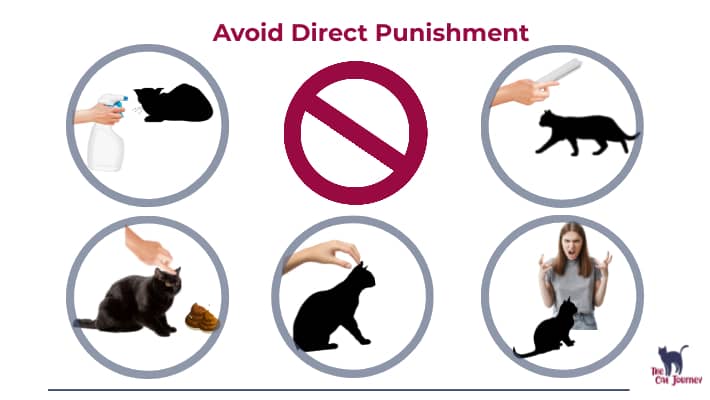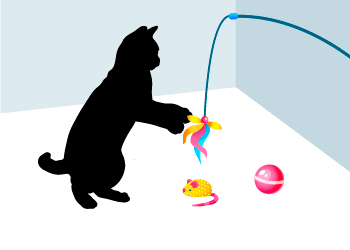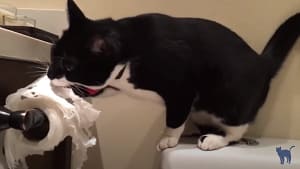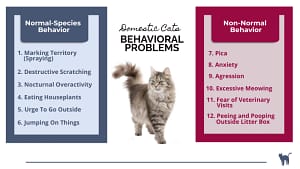Here are the 5 steps to follow to stop unwanted cat behavior:
- Learn about the most common cat behavior issues.
- Identify the trigger of the cat’s bad behavior.
- Get rid of the trigger if possible.
- Deter unwanted behavior:
- Don’t punish your cat,
- Redirect your cat’s behavior,
- Use Remote correction,
- Communicate with your cat,
- Give a timeout, and
- Use cat pheromones.
- Incentivize the desired behavior:
- Use positive reinforcement,
- Provide appropriate furniture,
- Make the litter box as friendly as possible,
- Make changes to the environment, and
- Play regularly with your cat.
Are you wondering how to stop unwanted cat behavior?
Your cat is misbehaving and you don’t know what to do?
A lot of theoretical information but nothing practical to apply immediately?
Cats are very intelligent animals. According to experts cats have both, long-term and short-term memory. That means they can learn and can be trained.
Many domestic cats’ unwanted behaviors are caused by their instincts. Others, instead, are just bad habits.
For this reason, letting your cat do whatever he or she wants is a terrible idea. Without the right guide, a cat will never understand which of its behavior is unacceptable to us.
Fortunately, changing your cat’s behavior is possible. The key is stopping the unwanted behavior the right way. Otherwise, you could damage your relationship with your cat and make the situation worse.
If your cat displays unwanted behavior, no more worries. In this article, I will show you practical tips that you can apply to teach your cat how to behave correctly.
Let’s start with some basic information.
Do Cats Misbehave on Purpose?

The straightforward answer is no. Cats have no notion of what is acceptable or unacceptable behavior.
They only care about meeting their basic needs. When a cat wants something, he or she just tries to get it.
If they are hungry, they will look for food; if they want to mark territory, they will scratch a piece of furniture; if they want to jump, they will climb on the kitchen furniture; and if they are bored, attacking your feet may be the only solution available.
We can suppose that our cat damaged our stuff because he was upset with us or as a reaction to something like us leaving him alone while we go to work. This is not the case.
Cats misbehave for legitimate, natural causes that have nothing to do with anger toward their owners.
Chances are they behave badly because they lack something the owners are unaware of. And sometimes, they develop bad habits.
Why?
Because we accepted or reinforced a certain behavior without paying attention. And now we either correct it or live with it.
If you want to do the former, keep reading. You will soon learn how to correct any bad behavior using a step-by-step process.
Why Is My Cat Suddenly Misbehaving?
Your cat is acting weird because he or she is unhappy or frustrated.
According to experts, cats develop undesired behavior as a result of the following factors:
- Caregivers unaware of the cat’s needs,
- Lack of contact and time spent between the cat and the owner, and
- Inadequate or ever-changing housing conditions.
Then, there are also other indirect factors to keep in mind:
- Medical issues (pain or disease);
- Traumas the cat endured before adoption;
- Uncastrated cats act according to their instincts.
Understanding these aspects is crucial if you want to improve your relationship with your cat. That’s why I’ve written an entire post on the topic:
Why Is My Cat So Badly Behaved? Discover the 6 Little Known Factors That Every Cat Owner Must Know
Understanding these aspects is crucial. It will help you better understand each step to follow.
How to Stop Unwanted Cat Behavior (Long Answer)
You might be unsure where to start. It could take some trial and error to get your cat to stop misbehaving. This is especially true if your prior cat was well-behaved and didn’t cause you any trouble.
Your job now is to figure out what needs the cat is seeking to meet and then provide a way for the cat to do so. More playtime, a place to scratch, things to climb, and so forth.
Also, because each cat is unique, some cats may respond well to particular “tricks” while others may not. There isn’t a single guideline that applies to all cats.
Although each problem has its solutions, the strategies for solving them are usually the same.
First, consult your veterinarian to rule out any medical issues. Cats are masters at hiding illness symptoms until it’s too late. Any behavior change could be a sign of an emerging medical condition
Once you’ve established your cat is healthy, you can start implementing strategies.
Let’s see each step in detail…
# 1 Learn About the Most Common Domestic Cat Behavioral Issues

Cats sometimes show behaviors that are hard to comprehend for their owners.
There are two common causes of a human-animal bond breakup. Unwanted behaviors, as well as a lack of knowledge on how to manage them. Unfortunately, resignation, desertion, and, in the worst-case scenario, euthanasia follow.
It’s never fun to have to relinquish a pet to a shelter. Even worse, if you feel you’re trapped in a situation where euthanasia is the only option to restore peace in your home.
Please, please, please don’t do it. It is not a good idea to abandon your pet. With the correct knowledge and a little patience, the solution is within your reach.
That said, let’s see what are the most common unwanted cat behaviors.
They fall into two types:
The first type refers to the typical- species behavior that the owner does not accept. These are the easiest to solve.
- Marking territory (Spraying);
- Destructive scratching;
- Nocturnal overactivity;
- Urge to go outside;
- Jumping on things;
- Eating plants;
The second type refers to behaviors that are triggered as a result of a poor quality environment, emotional trauma, or medical conditions. These unwanted behaviors include:
- Anxiety and stress;
- Excessive meowing;
- Fear of veterinarian visits.
- Peeing and pooping outside the litter box;
- Pica (eating non-edible objects like plastic);
- Aggression toward people, other cats, and dogs.
These cats’ behavioral issues are covered in detail in the following article:
Domestic cat behavior problems (the 12 most common explained)
Understanding those behaviors will help you to see things from the cat’s point of view. This also will allow you to determine the best strategy for your situation.
It’s time to put on your detective hat and start hunting for clues.
# 2 Identifying the Trigger of the Bad Behavior

Every unwanted behavior your cat acts out has a reason. However, such reasons are sometimes so hidden from us that we are blind to them.
To see the world through their eyes, we must wear feline glasses. That’s why I’ve listed the most common triggers below:
Physical Triggers
- Unpleasant odors can cause chronic stress to indoor cats. In fact, they can smell 14 times better than us.
- Loud noises can affect your cat’s behavior, they also have better hearing abilities than humans, so those can frighten them.
- A cold room can make them feel distressed since their ideal temperature is 86 – 100 °F (30-38 C°).
- A dirty or smelly litter box is another trigger. Cats like their toilets clean.
Lack of time alone and hiding places to rest. - Lack of scratching posts to scratch on to leave their territory marks and scent.
- Not having the opportunity to use their natural hunting instincts. They start feeling bored since their meal is always the same and is served in the same location.
- Lack of high places to climb on and see the room from above.
Psychological Triggers
- Abuse and/or abandonment by a prior owner.
- A new pet in the family like a puppy or a kitten.
- A new family member such as a baby or a partner.
- Lack of enough interaction and playtime with their owners.
- Poor socialization and early exposure to “fear” triggers as a kitten.
- A car accident or a fight with a dog.
- Changes in the environment, such as moving to a new house or changing the furniture.
Other Triggers
- Changes in hormone levels when cats are in heat.
- Medical issues cause aches and discomfort.
- Mental illnesses such as depression, anxiety, and feline hyperesthesia syndrome (FHS)
All these reasons could be possible triggers for the unwanted behavior. This is why you need to keep a close eye on your cat. Once you’ve figured out what’s causing the problem, you’ll be able to come up with a viable solution.
# 3 Get Rid of the Trigger if Possible

You may have to change the cat’s home environment to keep him or her away from the unwanted behavior trigger.
For example, let’s say your cat starts marking the perimeter of your house. He does it because he has seen a stray cat through the window that visits your backyard regularly. He perceives that an intruder is trying to invade his territory.
At this point, your cat’s only weapon is to communicate that this territory belongs to him. So he starts spraying the whole house with urine.
What should you do?
Simple: hang a curtain to block your cat’s visibility of what’s outside.
In other cases, a change in her routine may be a trigger. Let’s suppose you have bought a new scented litter. Then you realize your cat refuses to use it and starts doing her business on the floor next to the litter box. Again, simply switching to the old litter can do the trick.
It’s happened to me. On one occasion, I changed my cat’s litter because I thought a lavender-scented one was better.
Guess what?
He didn’t like it.
In fact, I didn’t know what scents do cats not like nor that lavender is one of them. My cat refused to use the litter box until I replaced the litter with the old one.
Luckily, I noticed his dissatisfaction on time. This gave me the chance to fix the problem before making him develop the bad habit of doing his business elsewhere
Many times we don’t even realize how stressed and unhappy our cats can be. In this sense, it becomes a priority to recognize the triggering factor.
# 4 Deter Unwanted Behavior
Do Not Punish Your Cat
Punishment is the application of a stimulus that “is supposed” to decrease the chance that a behavior will be repeated.
However, punishing your feline friend both physically or verbally is not a good idea. When it comes to training cats, according to experts, these methods turn out to be the least effective.
Unfortunately, reprimands are still one of the most frequently used. There is plenty of outdated or just inaccurate information about how to deal with cats’ unwanted behaviors.

Here is a quick list of things you should NOT do:
- Don’t hurt your cat intentionally. Spanking, hitting, kicking, and swatting with a newspaper or other object are all inadequate methods of discipline. As previously stated, it is ineffective and can potentially lead to more disruptive, even hostile behavior.
- Don’t yell to make a point. Your cat will not understand you any better if you raise your voice. Of course, he may recognize that a shift in your volume indicates something is different. But yelling may draw too much attention to bad behavior.
- Don’t scruff your cat. Adult cats should no longer be restrained or handled in this way. Scruffing is a painful experience. According to specialists, what appears to be calm is actually fear paralysis. Putting a blanket over him and scooping the cat within it is a better option. This will keep both you and the pet safe while also allowing you to transport the cat without worrying him further.
- Don’t rub your cat’s nose in an “accident”. The only thing you’re going to reach is to upset your cat. He’s not going to say he’ll never do it again. Cleaning the area thoroughly and continuing to work on litter box training is the best step in this process.
- Don’t spray water on your cat. You might be able to stop his behavior at that point, but your cat will most likely continue to misbehave once you leave the room. He will learn he can behave without punishment if you don’t see him.
Training a pet can be very frustrating when you’re learning together. However, avoid direct punishment at all costs.
Why?
Because this will only teach him to fear you and that he can behave however he wants when you are not around. Worse, it might lead to aggressive behavior.
Also, you should never try to change your cat’s behavior UNLESS he has access to the resources he needs to meet his natural needs.
For example, you have to place some scratching posts around your house. And you should do this before any attempts to correct destructive scratching behavior.
Redirect Your Cat’s Behavior
This involves offering your cat a more fun activity to do than the one he’s doing right now. This is by far the best way to let your cat know his behavior is not acceptable.

Let’s say your cat engages in rough or aggressive play during a play session. You can divert her attention away from it by giving her a large stuffed toy that she can vent her frustration on. Sprinkle the toy with some catnip to calm her down.
If your cat continues to bite or scratch you, walk into a nearby room and close the door. Before interacting with him again, wait until he has calmed down.
This will show him his behavior will not receive your attention and will prevent him from acting the same way in the future.
At first, your cat will not understand your behavior. You will have to be consistent and respond to the same behavior on every occasion. Over time, your cat will realize that any time he acts, the play session will be over.
Use Remote Correction
Remote corrections are corrections that your cat won’t associate with you. They take place indirectly through the use of loud noises or unpleasant smells, for example.
Remote correction is very effective.
Why?
Because an animal’s behavior is dictated by the implications of its previous behavior.
Using remote correction to your advantage requires you to connect it with a negative outcome your pet will experience.
If you want to apply it successfully, you must be out of sight while providing punishment.
Otherwise, your cat starts feeling afraid of you.
Cats are smart animals. Once they notice that doing something leads them to a bad experience, they’ll be less likely to do it again.
But how to remote correct your cat?
Here’re some tricks you can use:
Using texture. Certain surfaces irritate cats. Sticky paper, aluminum foil, and thick plastic are the most prevalent.
Assume your cat has begun clawing your new couch.

Placing aluminum foil in the areas you want to be off-limits may be enough to make the area less appealing to him.
Of course, you should take action as soon as possible to avoid your cat forming a preference for that location.
Using smell. Some odors bother cats, and they will try to avoid them.
Cats hate the smell of banana, pine, cedar, thyme, rosemary, and vinegar among others. You can also use commercial repellents.

Soak a piece of cloth or cotton ball in these smelly substances and place it wherever you don’t want your cat to go.
Keep in mind that they must be unpleasant enough to deter behavior in the first instance. Otherwise, your cat will quickly become used to the scent.
Communicate With Your Cat

Cats can learn and respond to words. For example, you can use the word “NO” every time your cat does something wrong. Your cat will build recognition and he will understand that hearing this word will have repercussions.
Over time the cat will wonder, “If I do this, they do that, so I better stop doing this.”
The same things happen when you shake the food container, for example. Your cat will rush towards you and start meowing because he knows what the outcome is: you’re going to give him those delicious treats he craves. Well, that’s a form of association. And so can become the word “no”.
If you catch your cat doing something he shouldn’t, say “no” with a firm tone of voice to stop him. During the lecture, avoid calling your cat by its name. Pick up your cat, carry it gently and show him what to do instead.
In this case, consistency in your language is crucial. It’s also important to know that sounding angry will almost certainly backfire. There’s a narrow line between being aggressive and firm, so just be clear and firm in your tone.
Give a Timeout

When it comes to this learning mode, cats are quite receptive. Turning your back on your cat may be one of the most effective ways to get your point across.
- First, because that is how mother cats train kittens.
- Second, cats dislike being ignored and left out of the action.
However, you must apply it as soon as the cat misbehaves.
Place your cat in a separate room away from people. Before interacting with him again, wait at least 20 minutes for him to calm down.
This will show him that his behavior is upsetting and will deter him from misbehaving in the future.
Quite often, he will emerge from the room with a different attitude.
Use Cat Pheromones

Clinical studies have shown that pheromone-based products help reduce or stop unwanted behaviors. The most treated are aggressiveness, destructive scratching, and urine marking. They are effective because pheromones calm down cats.
The most renowned and tested product is Feliway®. It’s a brand specialized in feline behavior control.
FELIWAY® simulates these pheromones, making cats calmer, more comfortable, and safer. It amplifies their olfactory signals since it contains the pheromone’s synthetic copy along with a small amount of catnip.
This pheromone is usually delivered through a diffuser or a spray and can be found at your local pet store.
Applying it in your household will:
- Relax your cat;
- Improve his or her behavior;
- Make better the relationship they have with other animals.
How does FELIWAY® CLASSIC work?
The FELIWAY® CLASSIC diffuser will send “happy messages” to provide peace of mind and prevent your cat from behaving out of fear or anxiety.
It’s also a valid option because it’s only detected by cats and sends the same message to all of them. Humans and other animals who live in the house are unaffected.
# 5 Incentivize the Desired Behavior
Use Positive Reinforcement

Positive reinforcement works perfectly with pets, just as it does with people. When cats get something they like, they remember it.
Praise them and give them healthy treats to teach them when they’re doing something you like. Make sure to reward your cat the moment he does something well, so he can make the association.
However, keep in mind that each cat may have different preferences. While most cats enjoy eating, others may prefer your attention or playtime with you.
To get your cat to do what you want, choose the perfect motivator. It’s best to use this special item to reward your cat while you’re training her for this specific behavior, at least at the start.
If you are not sure what your cat likes the most, the following are all good options:
- Tuna,
- Canned spray cheese,
- Shrimp, and
- Catnip toys.
Observe your cat and give him a treat if you see him laying near something he used to chew. Reward him if you notice him scratching the scratching post rather than your couch.
Your cat will quickly learn the difference between acceptable and unacceptable behavior.
Provide Appropriate Furniture
You must learn about cats’ typical-species behavior since you won’t be able to get rid of them. For example, you will never teach your cat to not scratch.
It’s paramount that you offer an equal or better alternative than the one your cat is now using.
Here’re some suggestions:
Cats need to leave their scents on their territory and sharpen their nails. Then provide him with a tall and stable scratching post.

Cats need to jump, to observe their territory from a high vantage point. That’s why they jump on your furniture. Then create an area for him where he can jump easily. A large cat tree or several shelves placed around the house can solve this behavior.

Cat needs his resting and hiding spot. A cardboard box could be enough. But if you want your house to look pretty, then several cat beds perfectly fulfill this function, like the ones I’ve shown you here.

You can prevent the cat’s unwanted behavior by making the inside as appealing and rewarding as possible. High perches, cat pathways, and safe basking locations on a catio will provide them with a rich environment.
Make the Litter Box as Friendly as Possible
Getting rid of litter box problems requires you to find the proper litter box, litter, and location that fit your cat’s preferences. Also, you need to clean the litterbox every day.
Some cats may have a preference for a specific odor, texture, or place. In truth.
- The litter (texture, depth, aroma, cleanliness),
- The box (size, shape, hood), or
- The placement.
May all affect the litter box’s attractiveness.
Here you can find a quick list to start:
- Clean the box at least once a day,
- Each cat should have at least one litter box.
- Make sure your cat has a large enough litter box with easy, low entry.
- Experiment with a different litter or a different location.
- Keep litter boxes away from noisy areas (such as next to the washing machine).

If your cat avoids using the litter box, also the following details are very important:
- When it comes to hygiene, cats are quite finicky. This implies scooping and replacing the litter daily, as well as cleaning the whole litter box once a week.
- Cats often dislike litter boxes with hoods and liners. Cats need to look around and see if someone is approaching from behind. If you have one of them, you should consider replacing it.
- In a multi-cat household, there should be a litter box for each cat, plus an extra one. Spread out the litter boxes so each cat has enough space to do his business in privacy. Look for a quiet area inside the house.
- Make sure there are one or two inches of litter in the litter box. Cats dislike litter boxes that have too much litter.
If you’ve gone through the checklist and your cat is still acting off, here are three more ideas:
- Reward him anytime he uses the litter box properly.
- If you catch your cat doing his business outside the litter box, pick him up and place him inside the box.
- If your cat has developed a preference area or surface, put the litter box there.
As a final recommendation, remember that peeing or pooping outside of the litterbox could be a sign of a medical issue. As common sense suggests, go to the vet for regular checkups. Doing it is important.
Make Changes to the Environment

You might make certain changes in your home to persuade your cat to stop his bad behavior.
You may take environmental measures to get your cat to quit jumping on your tables if you’re having trouble getting him to stop.
You could put a little pyramid of empty plastic on the arm of a chair, for example. The cat will stumble when climbing it, deterring him from doing it again.
Let’s say your cat has formed a preference for peeing on a particular surface, such as the bathroom carpet. Well, a piece of plastic carpet runner with the “nubs” pointing up may be enough to deter this activity.
Always remember not to make modifications that may damage your pet. There are plenty of cat-safe methods to change your cat’s behavior. Use your imagination.
Play Regularly With Your Cat

Many cats engage in unwanted behavior out of boredom. Like humans, cats need mental and physical stimulation.
In that sense, even playing with your cat might deter unwanted behavior. Cats like playing with their owners the most, according to new research. As a result, you must commit to daily play sessions with him.
Set aside 30-45 minutes for playtime every day. Divide playtime sessions into 10-15 minutes each. Most adult cats cannot stand long playtime sessions.
The most enjoyable activities are those that stimulate a cat’s hunting instincts. Wand toys with feather tips are perfect for him to play with.
Especially if your cat is one of those that enjoy rough play. They move like prey and have the benefit of keeping your cat a safe distance from your body.
As a last tip, try switching toys every week so he doesn’t get bored.
Playing with your cat daily not only helps prevent behavioral issues but also helps strengthen your relationship with him or her.
Conclusions
Congratulations! You’ve made it to the end. We’ve covered a lot of ground in this post on the unwanted cat’s behavior. First, we have learned that cats do not act “on purpose.” They act instinctively or because people have abused them and never for the sake of vengeance.
Cats don’t “think” like humans. They just want to meet their own needs. Keep this in mind if you are trying to correct a cat’s bad behavior.
The truth is that the only way to change your cat’s behavior is to start changing YOUR behavior. Cats do not have the power to change their environment or their needs. Only you, as a caregiver, have power over “whether,” “how,” and “when” those demands are met!
This might mean making adjustments to your cat’s physical surroundings. This might also mean starting new routines for yourself, such as scheduling daily playtime.
Besides what has already been said, the two essential takeaways are:
- First, provide him opportunities to exhibit typical-species behavior, and
- Second, praise him for doing so.
Now is your turn.
Have you ever used any of the strategies listed above?
Do you have any suggestions?
Please share your thoughts in the comments below.











13 Responses
some genuinely interesting info , well written and broadly speaking user genial.
Rather quite good topic
——
https://gravatar.com/peachteenage9a23339572
I firmly convinced, that you are not right. Time will show.
——
https://hosting.estate/tags/%D0%BF%D1%80%D0%BE%D0%B4%D0%B2%D0%B8%D0%B6%D0%B5%D0%BD%D0%B8%D0%B5%20%D0%BF%D0%BE%D0%B4%D0%BA%D0%B0%D1%81%D1%82%D0%B0/
Your message, simply charm
——
https://hackmd.io/@pqms4FLWRZmIeJOkzpYJ1w/HyOUgdRkWx
I am sorry, that I interfere, but you could not give little bit more information.
——
https://xsg.ru/internet/808-52e489a1685a8f878956cd0ebe19dc6a.html
I congratulate, your idea is very good
——
https://xtd.ru/tags/kde%20plasma%205%20%D0%BD%D0%B0%D1%81%D1%82%D1%80%D0%BE%D0%B9%D0%BA%D0%B0/
I join told all above. We can communicate on this theme. Here or in PM.
——
https://the.hosting/bg/vps-vds-norway-oslo
Yes, really. I agree with told all above.
——
https://the.hosting/no/amd-ryzen-dedicated-server
https://www.sitejabber.com/reviews/findycar.com
https://www.ecobluedirectory.com/gosearch.php?q=tickets-burj-khalifa.com&search-btn.x=6&search-btn.y=11
виртуальный номер для получения звонков https://continent-telecom.com
buy an american phone number
yacht noleggio